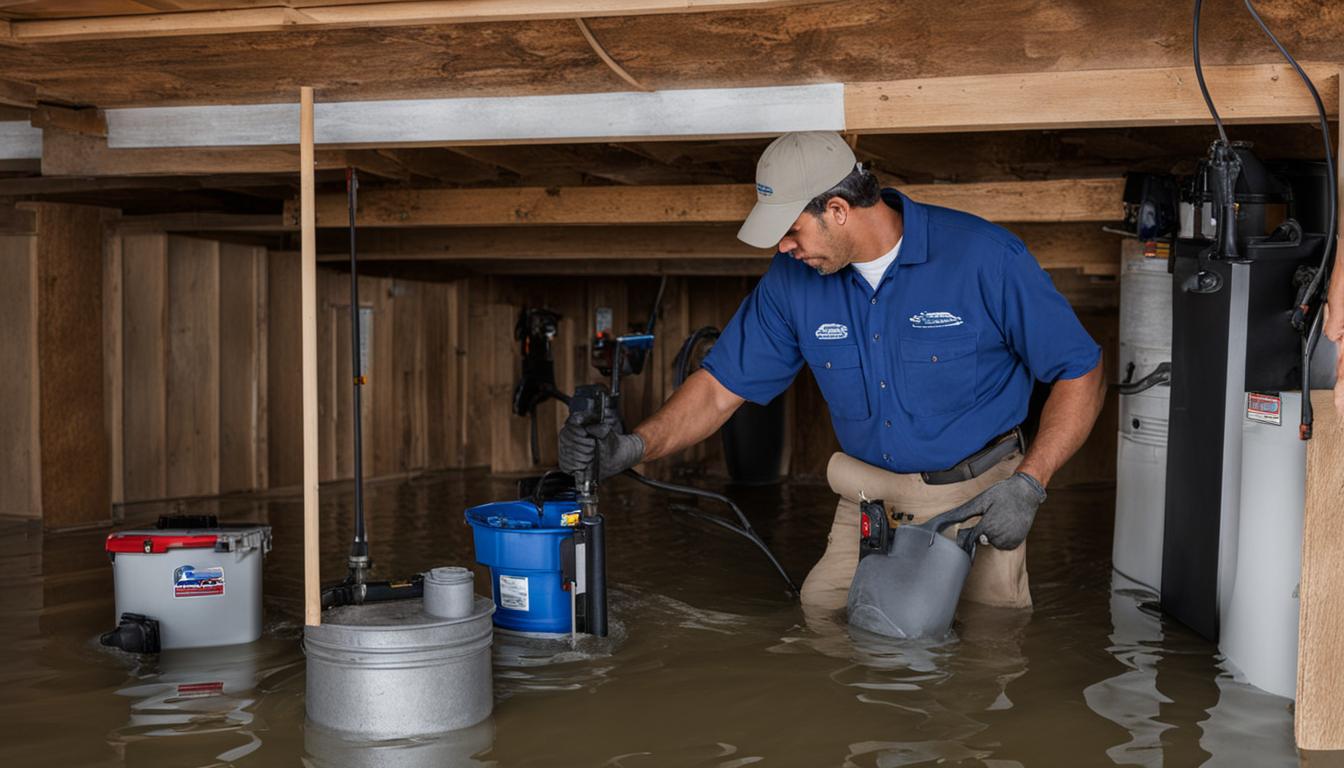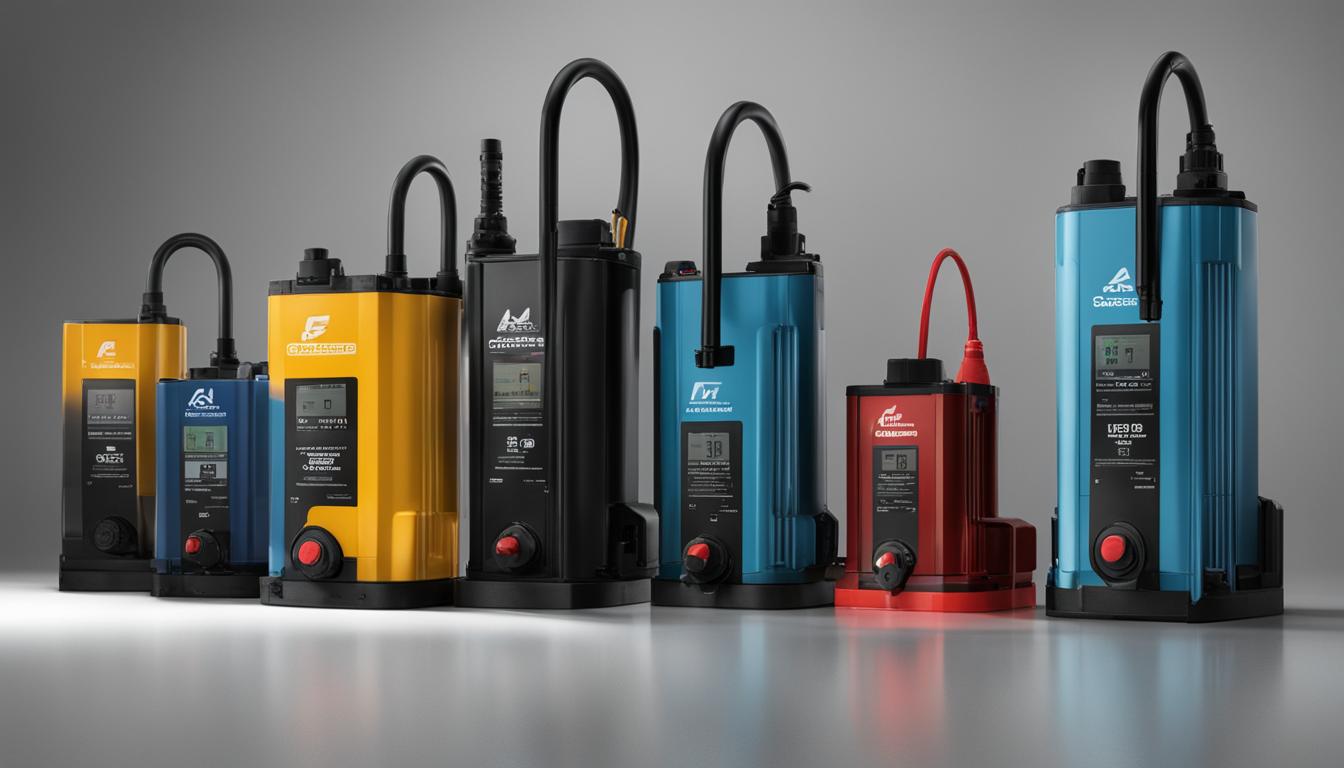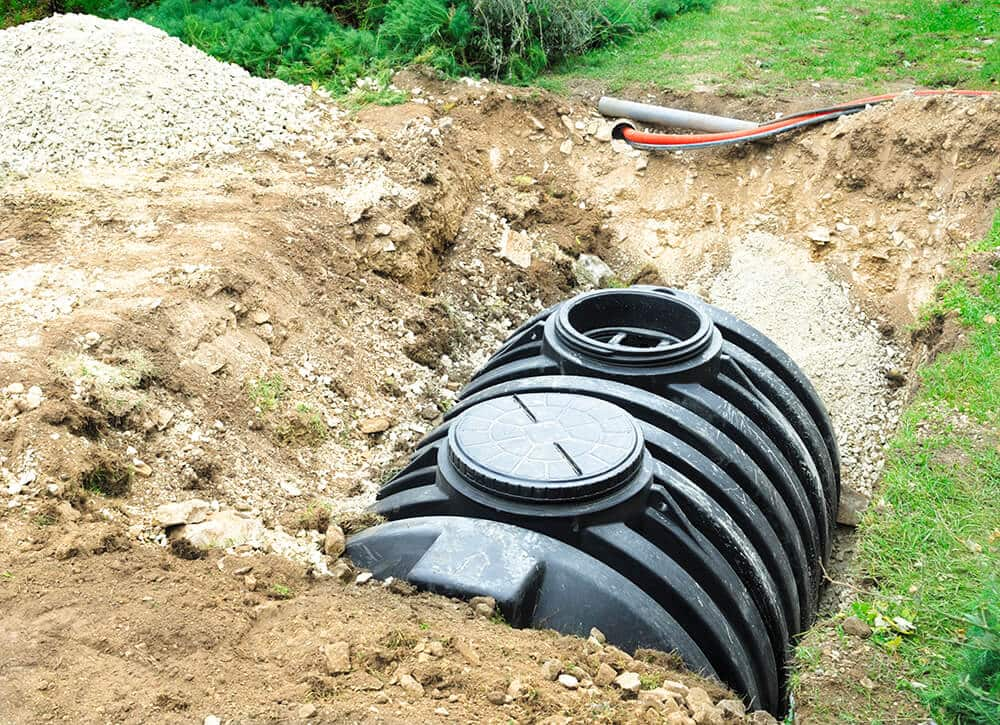As a homeowner with a septic system, it is essential to be aware of typical problems that may arise during septic tank maintenance. The early identification of these issues can help you avoid costly repairs in the future. In this section, we will discuss some of the most common issues that homeowners face when it comes to septic tank maintenance.
Key Takeaways:
- Regular septic tank pumping is vital for the health of your system.
- Clogged drainfields can lead to significant damage and system failure.
- Chemical overload and solid buildup in the tank can severely disrupt its proper functioning.
- Tree root intrusion is a common problem that homeowners face with septic systems.
- Septic tank alarms play a crucial role in alerting homeowners to potential issues.
Knowing When to Pump Your Septic Tank
Keeping your septic system healthy and functioning efficiently is essential for avoiding common septic care challenges. Regular pumping is one of the key maintenance tasks that can help you identify and address any potential issues with your septic system.
The frequency of septic tank pumping depends on factors such as the size of your tank and the number of people in your household. Typically, septic tanks should be pumped every 3-5 years. However, some systems may require more frequent pumping, while others may need it less often.
Identifying septic system maintenance challenges is critical to ensuring your system remains functional. Signs that your septic tank needs pumping include:
- Slow draining sinks or toilets
- Standing water or sewage backup in your yard or basement
- Unpleasant odors coming from your drains or yard
If you notice any of these symptoms, it’s essential to take action immediately. Neglecting septic system maintenance challenges can lead to significant problems down the line, such as drainfield failure or complete system malfunction.
Investigating the Cause of Pumping Issues
Identifying septic system maintenance challenges can sometimes be tricky. Suppose your septic tank requires more frequent pumping than usual, or you experience persistent issues with slow drains. In that case, it’s possible that there are underlying issues affecting your system.
These issues can include:
| Problem | Potential Cause |
|---|---|
| Excessive water usage | Leaky fixtures, outdated plumbing, or too many people using the system |
| Compacted soils | Heavy equipment driving over the drainfield or poor soil management |
| Excessive use of chemicals | Harsh cleaning products or excessive use of additives |
If you suspect any of these issues are affecting your septic system’s performance, it’s best to contact a professional septic system inspector to investigate further. They can provide guidance on identifying septic system maintenance challenges and help you make informed decisions to protect your system.
Proactively addressing potential issues with your septic system is crucial for avoiding common septic care challenges. Regular pumping, along with proper monitoring and maintenance, can help you keep your septic system functioning efficiently for years to come.
Signs of a Clogged Drainfield
Identifying issues with the drainfield early is crucial for maintaining the overall health of your septic system. Drainfield clogs can lead to backups, surface ponding, and other system failures. Here are some signs that your drainfield may be clogged:
- Slow drains: If you notice that your sinks, tubs, or toilets are draining slower than usual, it could be a sign of a clogged drainfield.
- Foul odors: An unpleasant smell near your drainfield or plumbing fixtures could indicate a blockage.
- Wet areas: If you notice wet or soggy spots in your yard, it may be a sign of drainfield flooding or backing up.
- Overgrown vegetation: Lush vegetation around your drainfield may indicate that the area is receiving excess water due to a clog.
If you notice any of these signs, it’s important to address the issue promptly to prevent further damage to your septic system. Some possible remedies for a clogged drainfield include:
- Pumping and cleaning: Regular pumping and cleaning of your septic tank can help prevent solids from entering and clogging your drainfield.
- Reducing water usage: Limiting water usage can reduce strain on your septic system and prevent overloading your drainfield.
- Diverting excess water: Diverting excess water away from your drainfield can help reduce pressure on the system and prevent flooding.
- Replacing damaged pipes: Damaged or collapsed pipes in your drainfield may need to be replaced to prevent blockages.
Conclusion
Identifying the signs of a clogged drainfield and taking prompt action can help prevent costly repairs and system failures. Regular maintenance, such as pumping and cleaning your septic tank and reducing water usage, can also help prevent drainfield clogs. If you suspect an issue with your septic system, it’s important to seek professional assistance to prevent further damage and ensure that your system is properly maintained.
Dealing with Tree Roots in the Septic System
One of the common septic care challenges faced by homeowners is tree root intrusion in the septic system. Tree roots, if left unchecked, can cause significant damage and may even lead to system failure. Here, we will examine some methods for identifying and resolving this issue.
Identifying Tree Root Intrusion
The first step in dealing with tree roots in the septic system is identifying the problem. Signs of root intrusion include slow draining fixtures, gurgling sounds in the plumbing, and foul odors emanating from the system. Additionally, visible tree roots in the yard around the septic tank or drainfield can also indicate root intrusion.
Tree roots can find their way into the septic system through small cracks or gaps in the pipes. Once inside, they can grow rapidly and cause blockages, leading to backups, flooding, and other issues. It is essential to address root intrusion as soon as possible to prevent further damage.
Resolving Tree Root Intrusion
There are various methods for resolving tree root intrusion in the septic system. One common approach is the use of root-destroying chemicals, which are applied to the affected pipes to kill the roots and prevent further growth.
Another option is mechanical removal of the roots using a plumbing snake or a high-pressure jetting system. This approach can be effective but may also damage the pipes, leading to further issues.
In some cases, replacement of affected pipes may be necessary to fully resolve the issue. It is best to consult with a licensed septic professional to determine the most appropriate course of action for your specific situation.
Preventing Future Tree Root Intrusion
Prevention is key when it comes to tree root intrusion in the septic system. One effective method is to plant trees and shrubs away from the septic system’s components, ensuring that roots cannot grow into the pipes.
Additionally, regular maintenance, such as regular pumping and inspection, can help identify and address any issues early on, before they turn into major problems.
By following these preventative measures and addressing any tree root intrusion issues quickly, you can ensure that your septic system remains healthy and functioning properly for years to come.
Malfunctioning Septic Tank Alarms
Septic tank alarms are crucial for detecting potential problems in the system. A malfunctioning alarm can lead to significant issues, such as system failure, leaks, and backups. In this section, we will discuss some typical septic system issues related to malfunctioning septic tank alarms and how to identify and address them.
Common Issues with Septic Tank Alarms
Septic tank alarms can malfunction in various ways, such as:
- The alarm may sound continuously, indicating a malfunction in the alarm’s wiring or switch.
- The alarm may not sound at all, implying a malfunctioning float switch or a faulty alarm system.
- The alarm may beep intermittently, indicating low battery levels.
It is essential to address these issues promptly to avoid costly and inconvenient problems in your septic system.
Addressing Malfunctioning Septic Tank Alarms
If you suspect that your septic tank alarm is malfunctioning, it is advisable to contact a licensed septic tank professional to perform an inspection. They can help you identify and fix the issue to prevent system failure and backups.
Here are some steps you can take to address common issues with septic tank alarms:
- Check the alarm’s power source, including the battery and electrical supply, to ensure it is functioning correctly.
- Inspect the float switch to ensure that it is not stuck and is floating correctly.
- Clean the float switch and the alarm system to remove any debris or buildup that may interfere with their function.
- Verify that the wiring is intact and not damaged.
- Reset the alarm system according to the manufacturer’s instructions.
Remember that prevention is key to avoiding malfunctioning septic tank alarms. Regular maintenance of your system can help you detect early signs of problems and address them promptly before they escalate.
Preventing Grease and Solid Buildup
One of the most common septic care challenges is preventing the buildup of grease and solids in the septic tank. Over time, these substances can cause blockages and disrupt the proper functioning of the system, leading to costly repairs and inconveniences. Fortunately, there are several preventive measures that homeowners can take to avoid this issue.
Watch What You Flush
One of the easiest ways to prevent grease and solid buildup is to be mindful of what you flush down the drain. Avoid pouring cooking oil, grease, and fats down the drain, as they can solidify and cause blockages. Additionally, avoid flushing non-biodegradable materials, such as cigarette butts, sanitary products, and disposable wipes, as they can also accumulate in the septic tank.
Use Enzyme-Based Cleaners
Enzyme-based cleaners can be used to break down organic matter in the septic tank and prevent the buildup of solids. These cleaners contain beneficial bacteria that can help digest food waste, toilet paper, and other materials. However, it’s important to use cleaners that are specifically designed for septic systems and to follow the instructions carefully, as using too much cleaner can disrupt the balance of bacteria in the system.
Pump Your Septic Tank Regularly
Regular pumping of the septic tank is essential for preventing solid and grease buildup. The frequency of pumping depends on several factors, such as the size of the tank, the number of occupants in the house, and the usage of water. Generally, it’s recommended to pump the septic tank every three to five years to remove accumulated solids. Pumping the tank can also help prevent backups and prolong the lifespan of the system.
Avoid Excessive Water Usage
Excessive water usage can overwhelm the septic system, leading to the buildup of solids and grease. To prevent this, avoid taking long showers, running the dishwasher or washing machine excessively, or allowing faucets to drip. Fixing leaks and installing low-flow fixtures can also help reduce water usage.
By following these tips, homeowners can prevent the common septic care challenge of solid and grease buildup, protecting their system and avoiding costly repairs in the future.
Avoiding Chemical Overload in the Septic System
In our experience, one of the typical septic system issues that homeowners face is chemical overload. While certain chemicals like bleach or drain cleaners may help to keep surfaces clean, they can pose a significant threat to the health of your septic system.
Why? Septic systems rely on a delicate balance of beneficial bacteria and enzymes to break down solid waste and keep the tank functioning correctly. If you introduce too many harsh chemicals into the system, it can kill off these essential microorganisms and disrupt the natural decomposition process. This can lead to various common septic care problems, such as foul odors, clogs, and backups, or even system failure in severe cases.
So, how can you avoid chemical overload in your septic system? Firstly, minimize your usage of harsh chemicals, particularly those containing bleach, caustic soda, or antibacterial agents. Instead, consider using natural cleaning agents like vinegar, baking soda, or essential oils that won’t harm the bacterial balance.
You can also reduce the number of chemicals that enter your septic system by avoiding flushing or draining any hazardous materials down your drains. Examples of things to avoid include:
- Pesticides and insecticides
- Paints and solvents
- Medications or drugs
- Automotive fluids
By being mindful of the products you use and what you put down your drains, you can reduce the risk of chemical overload and maintain a healthy septic system for longer.
Addressing Drainfield Flooding
Drainfield flooding is a common septic care challenge that requires quick action to prevent further damage to your septic system. There are many potential causes of drainfield flooding, including:
- Clogged drain pipes
- Tree roots invading the drainfield area
- Excessive rainfall or high groundwater levels
- A malfunctioning septic tank pump or alarm
Investigating typical septic tank care issues is crucial to identifying the cause of drainfield flooding and taking appropriate action. Here are some steps you can take:
Step One: Identify the Cause of Drainfield Flooding
To address drainfield flooding, we must first identify the underlying problem causing it. Is it due to excessive rainfall, a malfunctioning pump, or something else entirely?
One way to determine the cause of drainfield flooding is to have a professional septic service provider perform an inspection. They will be able to detect any clogs or damage to the system that may be contributing to the flooding.
Step Two: Address the Problem
Once you have identified the cause of the flooding, you can take action to address the problem. This may involve:
- Clearing clogged drain pipes
- Removing or cutting invading tree roots
- Installing a new septic tank pump or alarm
- Reducing water usage during periods of heavy rainfall or high groundwater levels
It is essential to take preventative measures to avoid future instances of drainfield flooding. This may involve:
- Regular septic system inspections and maintenance
- Properly disposing of waste and avoiding flushing non-biodegradable materials
- Avoiding excessive use of water during periods of heavy rainfall
By addressing drainfield flooding promptly and taking preventative measures, you can ensure the longevity and efficiency of your septic system, preventing costly repairs and interruptions to your daily life.
Repairing and Replacing Aging Septic System Components
Septic systems are complex and are comprised of several components that work together to ensure proper waste disposal. Over time, these components, such as the septic tank, drainfield, and pipes, may deteriorate due to age, use, or environmental factors. In this section, we will discuss the typical septic system issues that arise from aging components and provide guidance on how to address them.
Identifying Aging Components
To address aging components, you must first be able to identify them. Here are some typical septic system issues that may result from aging components:
- Slow draining sinks, tubs, and toilets
- Unpleasant odors in and around the septic tank
- Soggy or wet areas around the drainfield
- Pooling water on or near the drainfield
- Visible damage or deterioration of pipes or septic tank walls
If you notice any of these signs, it is crucial to address them promptly to avoid further damage to your septic system.
Repairing Aging Components
Repairing aging components can be a cost-effective option, but it depends on the extent of the damage. Small cracks in pipes or septic tanks may be repairable, but larger cracks or holes may require replacement. In some cases, replacing the entire septic system may be the best option, particularly if the system is outdated or no longer meets local regulations.
When repairing or replacing aging components, it is essential to hire a licensed professional. Septic systems are complex, and attempting to repair or replace them without proper knowledge and experience can lead to further damage and costly repairs.
Maintaining Aging Components
Regular maintenance can help extend the lifespan of aging septic system components. Here are some tips for maintaining aging components:
- Have your septic system inspected regularly by a licensed professional.
- Regularly pump your septic tank to avoid backups and reduce the load on aging pipes and drainfields.
- Avoid flushing non-biodegradable items, such as wipes, feminine hygiene products, and paper towels, down the toilet.
- Be mindful of what you pour down the drain, as some chemicals can harm septic systems.
- Avoid parking or driving heavy vehicles over septic system components, as this can cause damage.
By taking proactive measures to maintain your aging septic system components, you can help prolong their lifespan and avoid costly repairs or replacements.
Conclusion
Addressing aging septic system components is crucial for ensuring the proper functioning of your septic system. By identifying, repairing, and maintaining aging components, you can help extend the lifespan of your septic system and avoid costly repairs or replacements. Regular inspections, pumping, and mindful usage of your septic system can help keep it in top shape.
Conclusion
In conclusion, proper maintenance of a septic system is essential to avoid common issues that can lead to costly repairs and system failure. By identifying the typical problems that arise during septic tank maintenance, such as clogged drainfields and malfunctioning alarms, proactive measures can be taken to prevent them from occurring.
Regular pumping of the septic tank, preventing grease and solid buildup, and avoiding chemical overload are all important steps that can be taken to maintain a healthy septic system. In addition, addressing aging components, such as replacing old pipes or a failing drainfield, is crucial in extending the longevity and efficiency of the system.
Expert Guidance for Your Septic System
At [company name], we understand the importance of a properly functioning septic system. Our team of experts is here to provide guidance and solutions for all your septic care needs, from routine maintenance to complex repairs. Contact us today to learn more about how we can help keep your septic system in top shape.
FAQ
What are some common problems in septic tank maintenance?
Common issues in septic tank maintenance include clogged drainfields, tree roots invading the system, malfunctioning septic tank alarms, and buildup of grease and solids.
How do I know when it’s time to pump my septic tank?
It is recommended to pump your septic tank every 3 to 5 years. However, factors such as the size of your household and water usage may influence the frequency. Signs that indicate the need for pumping include slow drains, foul odors, and sewage backups.
What are the signs of a clogged drainfield?
Signs of a clogged drainfield include slow drains, gurgling sounds, sewage backups, and wet areas or odors around the drainfield. It’s important to address this issue promptly to prevent further damage to your septic system.
How do I deal with tree roots invading my septic system?
If you suspect tree roots are invading your septic system, consult a professional to assess the extent of the issue. Solutions may include root removal, installation of root barriers, or relocation of trees that pose a risk to your septic system.
What should I do if my septic tank alarm malfunctions?
If your septic tank alarm malfunctions, first check if there is a power source issue. If the alarm continues to malfunction, contact a professional to inspect and repair the alarm system. Regular maintenance of the alarm is crucial to ensure it functions properly.
How can I prevent grease and solid buildup in my septic tank?
To prevent grease and solid buildup, avoid pouring fats, oils, and grease down the drain. Additionally, limit the use of garbage disposals and only flush septic-safe materials. Regular pumping of the septic tank and proper maintenance will help prevent this issue.
How do I avoid chemical overload in my septic system?
Avoid excessive use of chemicals such as bleach, disinfectants, and strong cleaners, as they can disrupt the balance of beneficial bacteria in the septic system. Opt for environmentally friendly, septic-safe alternatives whenever possible.
What can I do to address drainfield flooding?
If you experience drainfield flooding, check for issues such as clogged lines or excessive water usage. Redirecting downspouts and managing surface water can also help prevent drainfield flooding. If the problem persists, consult a professional for further assessment and solutions.
How do I repair or replace aging septic system components?
Aging septic system components may require repair or replacement. If you notice signs of deterioration such as cracks, leaks, or inefficiency, contact a professional septic system contractor to assess the situation and provide appropriate solutions.
Conclusion
Understanding the typical problems in septic tank maintenance is crucial for keeping your system in top shape. By addressing these common issues proactively, you can extend the lifespan of your septic system and avoid costly repairs. Stay tuned for more expert guidance on septic system maintenance.






